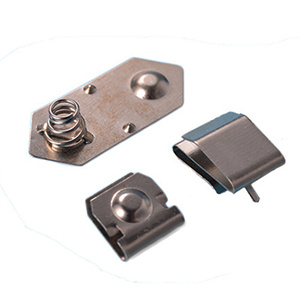Battery contacts rarely use blackening treatment. This is mainly due to the special needs and working environment of battery contact points.
Firstly, the main function of a Battery Contact is to ensure the stable transmission of current, therefore its conductivity is crucial. Although blackening treatment can enhance the corrosion resistance of metals, it may also affect their conductivity to some extent. In order to ensure good conductivity of battery contact, surface treatment methods that have a smaller impact on conductivity are usually chosen, such as gold plating, silver plating, etc.
Secondly, the working environment of a Battery Contact is usually quite unique, such as requiring it to withstand certain changes in current, voltage, and temperature. These factors may all affect the effectiveness and stability of blackening treatment. By contrast, some more durable surface treatment methods may be more suitable for the usage needs of battery contact.
Finally, the cost of blackening treatment is also one of the factors to consider. Compared to other surface treatment methods, blackening treatment may require more chemicals, equipment, and labor, thereby increasing costs. For large-scale production of Battery Contact, choosing a lower cost and better surface treatment method may be more appropriate.
Battery contacts rarely use blackening treatment, but there are still some advantages:
Enhance corrosion resistance: the black oxide film formed on the surface of battery contact can effectively block external corrosion factors, such as moisture, chemical substances, etc., to prevent the contact from rusting or being corroded during use, so as to extend the service life of battery contact. For example, electronic devices used outdoors have their battery contacts blacked out to better cope with complex and variable climatic conditions.
Reduction of contact resistance: high-quality blackening treatment can improve the surface microstructure of the contact, reduce the contact resistance, improve the efficiency and stability of current transmission, and ensure that the battery can stably supply power for the equipment.
Improve the abrasion resistance: the oxidation film produced by blackening treatment has a certain hardness and abrasion resistance, which can reduce the abrasion caused to the contact during the plugging and unplugging of the battery and maintain good contact performance.
Electromagnetic shielding: the black oxide film can provide electromagnetic shielding effect to a certain extent and reduce the impact of external electromagnetic interference on the battery contact signal transmission.
Identification and distinction: battery contacts of different specifications or purposes can be identified and distinguished through blackening treatment, so as to facilitate identification and management during production and maintenance.
